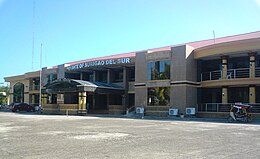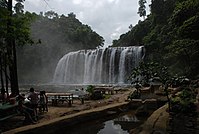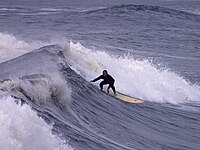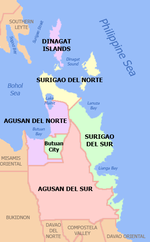Surigao del Sur
Surigao del Sur | |
|---|---|
(from top: left to right) Tinuy-an Falls in Bislig, White beach in Cagwait, surfer in beach of Lanuza, Hinatuan River, Britania Islands and Surigao del Sur Provincial Capitol. | |
| Nickname: Shangri-La by the Pacific[1] | |
 Location in the Philippines | |
| Coordinates: 8°40′N 126°00′E / 8.67°N 126°E | |
| Country | Philippines |
| Region | Caraga |
| Founded | June 19, 1960 |
| Capital | Tandag |
| Largest city | Bislig |
| Government | |
| • Type | Sangguniang Panlalawigan |
| • Governor | Alexander T. Pimentel (PDP–Laban) |
| • Vice Governor | Manuel O. Alameda (Hugpong Surigao Sur) |
| • Legislature | Surigao del Sur Provincial Board |
| Area | |
• Total | 4,932.70 km2 (1,904.53 sq mi) |
| • Rank | 21st out of 81 |
| Highest elevation | 611 m (2,005 ft) |
| Population (2020 census)[3] | |
• Total | 642,255 |
| • Rank | 47th out of 81 |
| • Density | 130/km2 (340/sq mi) |
| • Rank | 66th out of 81 |
| Demonyms |
|
| Divisions | |
| • Independent cities | 0 |
| • Component cities | |
| • Municipalities | |
| • Barangays | 309 |
| • Districts | Legislative districts of Surigao del Sur |
| Time zone | UTC+8 (PHT) |
| ZIP code | 8300–8318 |
| IDD : area code | +63 (0)86 |
| ISO 3166 code | PH-SUR |
| Spoken languages | |
| Income classification | 1st class |
| Website | www |
Surigao del Sur (Surigaonon: Probinsya nan Surigao del Sur; Cebuano: Habagatang Surigao; Tagalog: Timog Surigao), officially the Province of Surigao del Sur, is a province in the Philippines located in the Caraga region in Mindanao. Its capital is Tandag City while Bislig is the most populous city in the province. Surigao del Sur is situated at the eastern coast of Mindanao and faces the Philippine Sea to the east.
Etymology
[edit]There are two hypotheses on the original meaning of "Surigao" among linguists, depending on the original root word. If the root word was taken to be sulig ("sprout" or "spring up"), then Surigao may have derived from suligao ("spring water"), likely referring to the Surigao River (known as "Suligaw" in Mandaya) that empties at the northern tip of the island of Mindanao.[4][5] Early historical accounts record the name of the river as Suligao, Surigao, or Zurigan.[6]
Another possibility is that it is derived from Visayan surogao or suyogao, meaning "water current". From suyog (also sulog or surog), "current"; cf. Sinulog, Sulu, and Tausug (Suluk).[7]
History
[edit]
Early history
[edit]In precolonial times, the region of Surigao was inhabited by the Visayan Surigaonon people in the coastal areas, as well as Lumad groups in the interiors like the Mandaya, Mansaka, Mamanwa and Manobo.[8]
Spanish colonial era
[edit]During the Spanish Occupation in 1860, six military districts were created in Mindanao, with Surigao and Agusan forming the "East District". In 1870, the district was renamed to "Distrito de Surigao".
American invasion era
[edit]In 1901, Distrito de Surigao became chartered province. Agusan became an independent province in 1907 during the American era, when it was separated from Surigao.[8]
Philippine independence
[edit]Foundation
[edit]Surigao del Sur was created as the 56th Philippine province on June 19, 1960, through Republic Act 2786, separated from its mother province, Surigao, on September 18, 1960.[9]
At the time of its inception, it was classified as 4th Class province with an annual income of over ₱300,000.00. Seven years later, because of rapid increase of revenue collection particularly from the logging ventures, it has been reclassified as Ist Class B and in 1980 as Ist Class A with an estimated annual income of around ₱13,000,000. It has been reclassified as 2nd Class with a revenue adding up to ₱315,888,300.63.[citation needed]
Recaredo B. Castillo was the appointed first governor and subsequently elected governor while Vicente L. Pimentel was the first elected congressman.
The province was formed with 13 municipalities. Six more were added, raising the number to 19 with Tandag as the capital. Two of its municipalities have been elevated to cities; the first was Bislig City.
Contemporary
[edit]The capital town Tandag became a component city by virtue of Republic Act No. 9392 which sought to convert the town into a city. The law was ratified on June 23, 2007. However, the cityhood status was lost twice in the years 2008 and 2010 after the LCP questioned the validity of the cityhood law. The cityhood status was reaffirmed after the court finalized its ruling on February 15, 2011 which declared the cityhood law constitutional.
House Bill No. 2336 of the 19th Congress seeks to separate the southern part of the province to be formed as the new Province of Surigao Oriental. Once the bill is signed into law it will be approved and ratified in a referendum.
Geography
[edit]
Surigao del Sur is located along the northeastern coast of Mindanao facing the Philippine Sea between 125°40' to 126°20' east longitudes and 7°55' and 9°20' north latitudes. It is bounded on the northwest by the province of Surigao del Norte, on the southeast by Davao Oriental, on the west and southwest by Agusan del Norte and Agusan del Sur.
Situated west is the Diwata Mountain Range, isolating the province from the rest of Mindanao. To the east lies the Philippine Sea. The Mindanao Deep, one of the deepest trenches in the world, is situated a few kilometers east of the coastline.[10][8]
Land area
[edit]
The land area of the province is 4,932.70 square kilometres (1,904.53 sq mi)[11] representing 27.75 percent of the total land area of Caraga Administrative Region and about 5.14 percent and 1.74 percent of the total land area of Mindanao and Philippines, respectively. The province is elongated in shape, extending from the northeastern portion at Carrascal to the southernmost municipality of Lingig. It is approximately 300 kilometres (190 mi) in length and 50 kilometres (31 mi) at its widest point which runs from Cagwait to San Miguel.
Municipal-wise, San Miguel has the biggest land area accounting for 11.31% (558 square kilometers) of the total provincial land area while Bayabas has the smallest constituting only about 2.39% (117.84 square kilometers).[11]
Of the 5,230.50 square kilometres (2,019.51 sq mi) land, only 1,703.72 square kilometres (657.81 sq mi) or 32.22 percent are classified as alienable and disposable (A and D) while 3,583.523 square kilometres (1,383.606 sq mi) or 67.78 percent are forest land. Tagbina has the biggest share of alienable and disposable land with 234.21 square kilometres (90.43 sq mi) or about 56.51 percent of its land area followed by Hinatuan with 202.52 square kilometres (78.19 sq mi) or 63.56 percent of its land area.[citation needed]

Of the 3,583.523 square kilometres (1,383.606 sq mi) of forest land, 636.076 square kilometres (245.590 sq mi) are protection forest, 2,582.43 square kilometres (997.08 sq mi) production forest, 12.68 square kilometres (4.90 sq mi) are non-forest agriculture and 352.337 square kilometres (136.038 sq mi) are for non-forest mining. As of today, the province still has vast areas of remaining old growth and mossy forest.[citation needed]
Climate
[edit]The province falls under Type II climate of the Philippines, characterized by rainfall distributed throughout the year, although there is a distinct rainy season which begins from the month of November and ends in March. However, the climatic behavior of the province for the past few years has shown variations wherein the onset of the rainy seasons no longer occurs on the usual time. Months with low rainfall are from July to October with September as the driest month. Wet months are from November to June with January as the wettest month.
Surigao del Sur is one of the top 20 most vulnerable provinces to climate change in the Philippines.[12]
| Climate data for Surigao del Sur | |||||||||||||
|---|---|---|---|---|---|---|---|---|---|---|---|---|---|
| Month | Jan | Feb | Mar | Apr | May | Jun | Jul | Aug | Sep | Oct | Nov | Dec | Year |
| Mean daily maximum °C (°F) | 29.6 (85.3) |
30.0 (86.0) |
30.8 (87.4) |
31.6 (88.9) |
32.0 (89.6) |
32.2 (90.0) |
32.3 (90.1) |
32.5 (90.5) |
32.5 (90.5) |
32.2 (90.0) |
31.2 (88.2) |
30.6 (87.1) |
31.5 (88.6) |
| Mean daily minimum °C (°F) | 23.4 (74.1) |
23.2 (73.8) |
23.6 (74.5) |
24.2 (75.6) |
24.4 (75.9) |
24.3 (75.7) |
24.1 (75.4) |
24.3 (75.7) |
24.1 (75.4) |
24.0 (75.2) |
23.9 (75.0) |
23.7 (74.7) |
23.9 (75.1) |
| Average rainy days | 24 | 21 | 20 | 19 | 16 | 16 | 14 | 14 | 13 | 17 | 17 | 21 | 212 |
| Source: Storm247 [13] | |||||||||||||
Administrative divisions
[edit]Surigao del Sur comprises 17 municipalities and two cities, further subdivided into 309 barangays. There are two congressional districts encompassing all cities and towns.

- † Provincial capital and component city
- ∗ Component city
- Municipality
| ||||||||||||||||||||||||||||||||||||||||||||||||||||||||||||||||||||||||||||||||||||||||||||||||||||||||||||||||||||||||||||||||||||||||||||||||||||||||||||||||||||||||||||||||||||||||||||||||||||||||||||||||||||||||||||||||||||||||||||||||||||||||||||||||||||||||||||||||||||||||||||||||||||
Demographics
[edit]| Year | Pop. | ±% p.a. |
|---|---|---|
| 1903 | 42,346 | — |
| 1918 | 55,421 | +1.81% |
| 1939 | 99,981 | +2.85% |
| 1948 | 109,949 | +1.06% |
| 1960 | 165,016 | +3.44% |
| 1970 | 258,680 | +4.59% |
| 1975 | 302,305 | +3.17% |
| 1980 | 377,647 | +4.55% |
| 1990 | 452,098 | +1.82% |
| 1995 | 471,263 | +0.78% |
| 2000 | 501,808 | +1.36% |
| 2007 | 545,902 | +1.17% |
| 2010 | 561,219 | +1.01% |
| 2015 | 592,250 | +1.03% |
| 2020 | 642,255 | +1.61% |
| Source: Philippine Statistics Authority[14][15][16] | ||
The population of Surigao del Sur in the 2020 census was 642,255 people,[3] with a density of 130 inhabitants per square kilometre or 340 inhabitants per square mile.
The province is home to the Kamayo, Agusan, and the eponymous Surigaonon peoples, with the latter ethnolingustically related to the Visayan ethnic groups (though geographically native in Mindanao). Their dances are showcased in the local festival, "Sirong Festival", held especially during the town fiesta of Cantilan. The Sirong Festival depicts the early Christianization of the early Cantilan inhabitants where the natives tried to defend their land against Visayan invaders. Other residents in the province include the migrants (and their native-born descendants) from Ilocandia, Cagayan Valley, Cordillera Administrative Region, Central Luzon, Calabarzon, Mindoro, Marinduque and Bicolandia in Luzon and Panay, Negros, Central and Western Visayas, as well as Chinese and white Europeans (eg. Spaniards and white Americans) and their native-born descendants.
The indigenous people of the province were largely Christianized during the early times of the Spanish conquest.
Languages
[edit]The Surigaonon and Tandaganon languages are spoken in most parts of Surigao del Sur (except in Bislig and the towns of Barobo, Hinatuan, Lingig and Tagbina, where most of the inhabitants speak Cebuano and their native Kamayo, a different language but one distantly related to Surigaonon, is spoken by the rest of the population), with the Cantilangnon dialect, a northern variety of Surigaonon that is very much similar to the dialect of Surigaonon as spoken in Surigao del Norte, being spoken mostly in the five northern municipalities of the province, namely Carrascal, Cantilan, Madrid, Carmen and Lanuza (or the municipal cluster called Carcanmadcarlan); these municipalities were once under a single Municipality of Cantilan before December 10, 1918.
Tagalog and English are also widely spoken throughout the province and used as the primary languages of education, business, and administration.
Economy
[edit]
Surigao del Sur is one of the suppliers of rice, bananas and other tropical fruits. Copper, chromite and silver are also found here. Marine and aquaculture are abundant in the province, being primary livelihoods of the inhabitants as the province is well known for producing seafood and sea by-products.
Mineral resources
[edit]Surigao del Sur is endowed with metallic minerals such as copper, gold, chromite, cobalt, nickel and lead zinc, as well as non-metallic (limestone, coal and feldspar, clay diatomite/bentomite and coarse/fine aggregates). There are small and large scale mining activities in the province. Corporations operating in a large scale are the Marc Ventures Mining Development Corporation at Carrascal and Cantilan, operating in an area of 4,799 hectares (47.99 km2) within the Diwata Mountain Range.[24][25] The [TP Construction and Mining Corporation, also in Carrascal, focuses on gold and nickel mining in an area of 35.64 square kilometres (13.76 sq mi) and 48.6916 square kilometres (18.80 sq mi), respectively. The Carac-an Development Corporation, also in Carrascal, has an area of 506.3764 square kilometres (195.51 sq mi). Small scale mining activities are found in the municipalities of Barobo, Carmen and San Miguel.
Tourism
[edit]Bislig's main tourist attraction is the Tinuy-an Falls,[26] known as the little "Niagara Falls of the Philippines". It is a white water curtain that flows in three levels about 55 metres (180 ft) high and 95 metres (312 ft) wide.[27] Its unique natural formation once appeared in the International Travel Magazine. It is also known as the widest waterfall in the Philippines.[citation needed]
Surfing in Surigao del Sur is widely known and has been one of the local tourist attractions. This extreme sport is often practiced in Cantilan and Lanuza.[28] Skimboarding is also found in several municipalities, attracting tourists.
-
Deep-blue waters of the renowned "Hinatuan Enchanted River", an underground river in Barangay Talisay, Hinatuan
-
The Tinuy-an Falls in Burboanan, Bislig
-
Surfing in Lanuza
Notable people
[edit]- Marcelito Pomoy - singer and Pilipinas Got Talent (season 2) Grand Winner and America's Got Talent: The Champions finalist
- Gabriel Amigo III - international Enduro mountain bike racing champion
- Dennis Orcollo - professional pool player; Billiard Congress of America Hall of Fame inductee
- Elmar Sillador - 1992 Philippine National Police Medal of Valor recipient[29]
- Prospero Arreza Pichay, Jr. (Butch Pichay) - son of Provincial Treasurer Prospero Pichay Sr. He became the Congressman of Surigao del Sur 1st district from 1998 until 2007.
- Lt. Gen. William Hotchkiss III - member of the famed Blue Diamonds, a combat ready pilot.
- Gen. Hernando Delfin Carmelo Arreza Iriberri, PMA Class "Matikas", 1983 - became the Commanding General of the Philippine Army (56th) and the 46th Chief of Staff of the Armed Forces of the Philippines.[30]
See also
[edit]References
[edit]- ^ Caraganon.com
- ^ "List of Provinces". PSGC Interactive. Makati, Philippines: National Statistical Coordination Board. Retrieved April 1, 2014.
- ^ a b c Census of Population (2020). Table B - Population and Annual Growth Rates by Province, City, and Municipality - By Region. Philippine Statistics Authority. Retrieved July 8, 2021.
- ^ Philippine Institute of Traditional and Alternative Health Care, Department of Health; University of the Philippines Manila; University of the Philippines Mindanao (2000). "Ethnomedical documentation of and community health education for selected Philippine ethnolinguistic groups: the Mandaya people of Davao Oriental, Philippines" (PDF). Retrieved April 22, 2015.[permanent dead link]
- ^ Benito Francia y Ponce de Leon; Julián González Parrado (1898). La Islas Filipinas. Mindanao, Volume 1. Subinspección de Infantería. p. 197.
- ^ Pio A. De Pazos y Vela-Hidalgo, ed. (1879). Jolo, Relato Historico-Militar: Desde Su Descubrimiento Por Los Espanoles en 1578 A Nuestros Dias (1879). Imprenta y Estereotipia de Polo.
- ^ Paredes, Francis Tom; Paredes, Sheila (2017). The Monosyllabic root -ao in Mindanao Languages. 8th Annual In-house Review of the Research Office of Agusan del Sur State College of Agriculture and Technology. Agusan del Sur State College of Agriculture and Technology.
- ^ a b c Lancion, Conrado M. Jr. (1995). "The Provinces; Surigao del Sur". Fast Facts about Philippine Provinces. cartography by de Guzman, Rey (The 2000 Millenium ed.). Makati, Metro Manila, Philippines: Tahanan Books. p. 156. ISBN 971-630-037-9. Retrieved April 28, 2016.
- ^ "Republic Act No. 2786 - An Act to Create the Provinces of Surigao del Norte and Surigao del Sur". Chan Robles Virtual Law Library. June 19, 1960. Retrieved January 11, 2016.
- ^ "Philippine Provincial Profile; Surigao del Sur". OoCities.org. Retrieved April 28, 2016.
- ^ a b c d "Province: Surigao del Sur". PSGC Interactive. Quezon City, Philippines: Philippine Statistics Authority. Retrieved January 8, 2016.
- ^ "About Caraga". National Economic and Development Authority Caraga. Retrieved May 13, 2022.
- ^ "Weather forecast for Surigao del Sur, Philippines". Storm247.com. Bergen, NO: StormGeo AS. Retrieved April 29, 2016.
- ^ a b Census of Population (2015). Highlights of the Philippine Population 2015 Census of Population. Philippine Statistics Authority. Retrieved June 20, 2016.
- ^ Census of Population and Housing (2010). Population and Annual Growth Rates for The Philippines and Its Regions, Provinces, and Highly Urbanized Cities (PDF). National Statistics Office. Retrieved June 29, 2016.
- ^ Census of Population and Housing (2010). "Caraga" (PDF). Total Population by Province, City, Municipality and Barangay. National Statistics Office. Retrieved June 29, 2016.
- ^ "Poverty incidence (PI):". Philippine Statistics Authority. Retrieved December 28, 2020.
- ^ "Estimation of Local Poverty in the Philippines" (PDF). Philippine Statistics Authority. November 29, 2005.
- ^ "Annual Per Capita Poverty Threshold, Poverty Incidence and Magnitude of Poor Population, by Region and Province: 1991, 2006, 2009, 2012 and 2015". Philippine Statistics Authority. August 27, 2016.
- ^ "Annual Per Capita Poverty Threshold, Poverty Incidence and Magnitude of Poor Population, by Region and Province: 1991, 2006, 2009, 2012 and 2015". Philippine Statistics Authority. August 27, 2016.
- ^ "Annual Per Capita Poverty Threshold, Poverty Incidence and Magnitude of Poor Population, by Region and Province: 1991, 2006, 2009, 2012 and 2015". Philippine Statistics Authority. August 27, 2016.
- ^ "Updated Annual Per Capita Poverty Threshold, Poverty Incidence and Magnitude of Poor Population with Measures of Precision, by Region and Province: 2015 and 2018". Philippine Statistics Authority. June 4, 2020.
- ^ "2021 Full Year Official Poverty Statistics of the Philippines" (PDF). Philippine Statistics Authority. August 15, 2022. Retrieved April 28, 2024.
- ^ "Marcventure's mining operations in Cantilan, Surigao del Sur, Philippines". Environmental Justice Atlas. Retrieved April 18, 2016.
On July 1, 1993, Marcventure Mining and Development Corporation (MMDC) received a mining permit covering 4,799ha, located in the Diwata Mountain Range, Cantilan, Surigao del Sur.
- ^ Galvez, James Konstantin (April 24, 2014). "DENR shuts down Surigao del Sur mining firm". The Manila Times. Retrieved April 18, 2016.
MMDC, a subsidiary of publicly listed Marcventures Holdings Inc., is engaged in nickel production in Surigao del Sur. The company holds a mineral production sharing agreement (MPSA) for a 4,799- hectare tenement located in Cantilan, Surigao del Sur.
- ^ Crismundo, Mike (September 22, 2015). "Caraga tourist arrivals to reach 2M by end of 2015". Manila Bulletin. Retrieved April 18, 2016.
Frequently visited by this huge volume of tourists are the famous "Cloud 9" and amazing beach resorts and islets in Siargao Island, the Sohoton Cove in Bucas Grande Island in Socorro town, the game fishing hub in Pilar, all in Siargao Island in Surigao del Norte, the Enchanted River in Hinatuan, Surigao del Sur, the Tinuy-an Falls in Bislig City and Balanghai in Butuan City.
- ^ Alcantara, Jojie (February 11, 2005). "Tinuy-an Falls: Our little Niagara". Sun.Star Davao. Archived from the original on April 28, 2005. Retrieved April 18, 2016.
Tinuy-an is a three-tiered falls (there is a fourth but cannot be seen from view) about 55 meters high and a breathtaking width of 95 meters, supposedly the widest in the country.
- ^ Mascariñas, Erwin (November 11, 2012). "LGU wants to make Cantilan a surfing destination". MindaNews. Mindanao News and Information Cooperative Center. Retrieved April 28, 2016.
- ^ Evangelista, Romie (January 30, 1992). "PNP marks 1st anniversary". Manila Standard. Kamahalan Publishing Corp. p. 6. Retrieved April 25, 2021.
- ^ "BGen.Hernando Iriberri". Philippine Daily Inquirer. Appointed commander of the Army’s 503rd Brigade in Abra province. Retrieved January 31, 2013.
External links
[edit] Media related to Surigao del Sur at Wikimedia Commons
Media related to Surigao del Sur at Wikimedia Commons Geographic data related to Surigao del Sur at OpenStreetMap
Geographic data related to Surigao del Sur at OpenStreetMap- Local Governance Performance Management System Archived March 4, 2016, at the Wayback Machine
- Surigao del Sur provincial profile at Philippine Provincial Profiles













